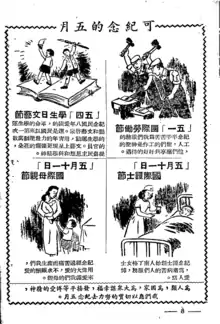Literary Day
Literary Day is observed annually on May 4 in Taiwan, in honor of the May Fourth Movement.[1] It was first celebrated on this day in 1945, and its establishment was affected by the dispute over whether the Kuomintang or the Communist Party was the legitimate successor to the May Fourth Movement, disagreements about how to interpret the movement, and other cultural struggles.[2]
| Literary Day | |||||||
|---|---|---|---|---|---|---|---|
| Traditional Chinese | 五四文藝節 | ||||||
| Simplified Chinese | 五四文艺节 | ||||||
| Literal meaning | May Fourth Literature and Art Day | ||||||
| |||||||

Historical origins
On May 4, 1920, the first celebrations of the anniversary of the May Fourth Movement were held across China. Well-known figures such as Liang Qichao and Cai Yuanpei published articles speaking highly of the student demonstrations. In the 1920s, amid confrontations between the Guangzhou government and the Beiyang government, the Beiyang government prohibited rallies and marches commemorating the May Fourth Movement in Beijing and Tianjin, so the center of May Fourth Movement commemorations moved to Nanjing and Shanghai. In 1923, the National Student Association notified local student associations of a resolution that each student association was to hold a commemorative rally each year. With the May Ninth National Humiliation (五九國恥) and the May Third incident, the beginning of May began to accumulate anti-Japanese observances, and as the conflict between China and Japan deepened, the May Fourth anniversary became a symbol of anti-Japanese resistance. In 1933, more than a year after the Mukden Incident, one of the rallies declared May 4 as the "Anniversary of the Movement to Rejuvenate Chinese Culture".[3]
Literary Day was originally designated by the Nationalist government as March 27, in honor of the establishment of the All-China Resistance Association of Writers and Artists, while Youth Day was originally designated as May 4, in honor of the Three Principles of the People Youth Corps.[2][4] The Shaan-Gan-Ning Border Region Northwestern Youth National Aid Association formally declared May 4 as Youth Day in March 1939. Mao Zedong wrote an article praising the May Fourth Movement, and the same year, the Republic of China government designated May 4 as Youth Day.[3][5] On May 4, 1939, the Kuomintang (KMT) and the Communists both celebrated the first May Fourth Youth Day.[3]

In 1940 or 1943, the KMT government moved Youth Day to March 29 to commemorate the martyrs of the Yellow Flower Mound Uprising.[2][3] The move provoked opposition: for instance, on May 3, 1944, National Southwestern Associated University held a symposium on the topic of "protecting the May Fourth spirit, carrying forward the May Fourth tradition". During the Chinese Civil War, the Kuomintang-established observance of Youth Day on March 29 became an occasion for people to express their dissatisfaction with the Kuomintang. The Communist Party took the opportunity to instigate a student movement for "survival, freedom, and peace".[3]
In 1944, the KMT government changed the May Fourth observance to Literary Day, and the new observance was celebrated for the first time in 1945.[2] In 1949, the new People's Republic of China Government Administration Council changed it back to Youth Day, and this difference in observance between the PRC (mainland China) and the ROC (Taiwan) persists to this day.[3]
In Taiwan
During the post-war period in Taiwan, when bensheng (Taiwanese-origin) authors discussed the May Fourth Movement, they emphasized the impact of the New Culture Movement on Taiwan starting during the period of Japanese rule. Waisheng (mainland-origin) authors focused on the May Fourth Movement resisting the Kuomintang's suppression of speech, or on the hope that the spirit of the movement would eliminate the remnants of Japanese culture in Taiwan and reestablish Chinese culture.[2]
The Kuomintang government did not carry out any activities in Taiwan commemorating the May Fourth Movement during the period from 1945 to 1949,[2] but on May 4, 1950, the Chinese Writers' and Artists' Association was established in Taipei,[6] and in the 1950s, the Kuomintang government established the May Fourth literary award and began designating May 4 as Literary Day each year. They also began organizing events to commemorate the May Fourth Movement.[7] Local government organizations, including in Matsu and Taoyuan, have held various events to celebrate Literary Day.[8][9][10] The Chinese Writers' and Artists' Association organizes activities and celebrations, as well as awarding the Chinese Literary Award, which has more than 800 recipients to date.[11] The president of the Republic of China (Taiwan) has also hosted events and presented literary awards.[12]
The holiday is also celebrated by overseas Chinese, including in Los Angeles[13] and San Francisco.[14]
See also
References
- "May Fourth Literary Day Celebration-National Central Library". enwww.ncl.edu.tw. Retrieved April 1, 2021.
- 陳建忠 (May 5, 2011). "五四文藝節". 臺灣大百科全書. Retrieved July 18, 2019.
- 楊濤 (2010). "民國時期的"五四"紀念活動" (PDF). 二十一世紀雙月刊 (2010年6月號.總第一一九期). Archived (PDF) from the original on May 16, 2018. Retrieved July 19, 2019 – via 香港中文大学.
- 游桂香 (May 5, 2016). "【藝起飛揚—馬祖藝文節】馬祖的「民國讀書伯」與「五四文藝節」". 馬祖日報. Archived from the original on May 27, 2020. Retrieved July 19, 2019.
- 尹萍 (April 15, 1989). "一枝帶刺的玫瑰| 遠見雜誌". 遠見雜誌 – 前進的動力. Retrieved July 19, 2019.
- 楊樹清 (May 16, 2009). "金門五四少年看見了一個時代". 金門日報. Retrieved July 20, 2019.
- 黃怡菁 (2010). "文學史的書寫形態與權力政治:以《中華民國文藝史》為觀察對象" (PDF). 台灣學誌 (創刊號): 75-97. Archived from the original (PDF) on July 19, 2019.
- 林錦鴻 (May 4, 2016). "藝起奔馳--馬祖的五四文藝節". 馬祖日報. Retrieved July 19, 2019.
- 簡榮霖. "桃園縣政府提前歡度五四文藝節". 自立晚報. Retrieved July 20, 2019.
- 彭婷婷. "本館慶祝二十六週年館慶暨五四文藝節". 歷史館刊 創刊號 (in Chinese). 國立國父紀念館. Archived from the original on July 20, 2019. Retrieved July 20, 2019.
- "〈北部〉全國文藝節60歲 各國詩人慶生 – 地方 – 自由時報電子報". 自由電子報. May 4, 2010. Retrieved July 19, 2019.
- "總統主持105年五四文藝節文化界人士授勳典禮". 总统府. Retrieved July 19, 2019.
- "洛杉磯華僑文教服務中心 – 全球僑社動態". 中華民國僑務委員會. Archived from the original on September 9, 2020. Retrieved August 1, 2019.
北美南加州華人寫作協會3日在蒙特利公園市長青文化廣場,舉辦慶祝協會成立27週年藝文大展暨五四文藝節紀念大會,並舉辦「台灣學運與五四運動的比較」討論會。
- 胡健宏 (May 3, 2009). "慶祝五四文藝節 夏祖焯專題演講感性美學". 星島日報. Archived from the original on August 1, 2019. Retrieved August 1, 2019 – via 北美新浪網.
為了慶祝五四文藝節,北美中華新文藝學會特別在華埠國父紀念館舉行文學座談會……為了慶祝文藝節,昨日學會更特別邀請到夏祖焯教授擔任主講嘉賓。